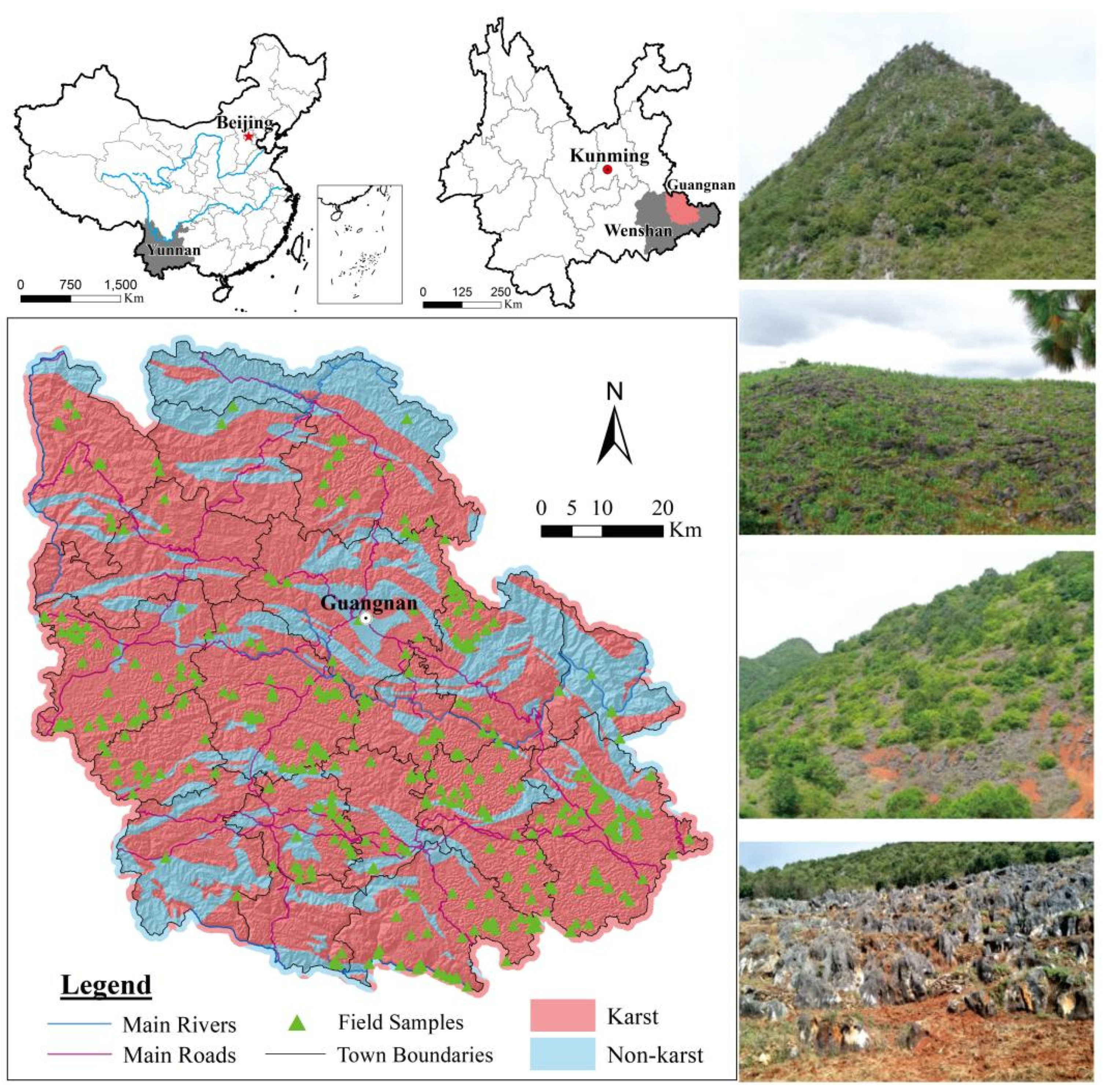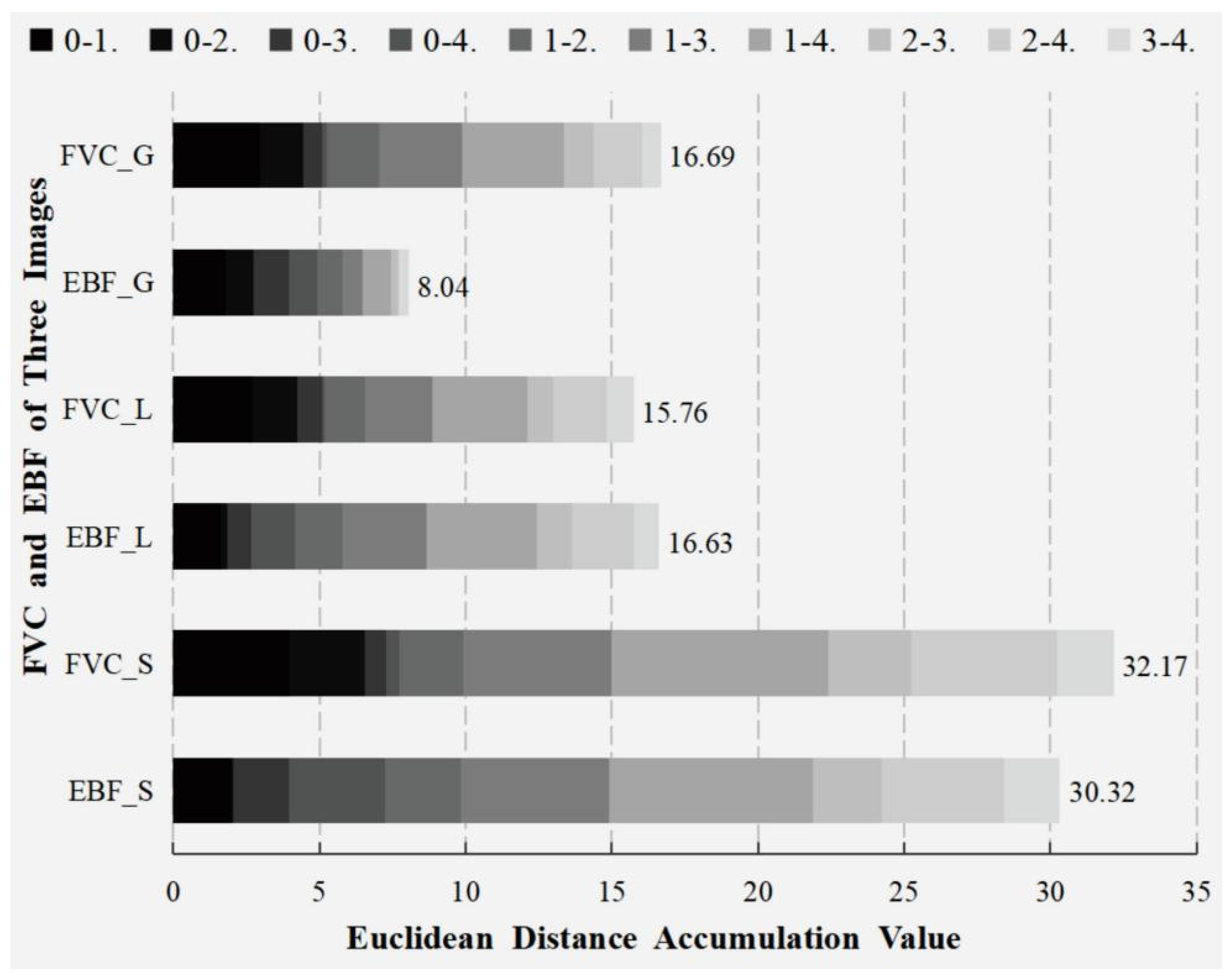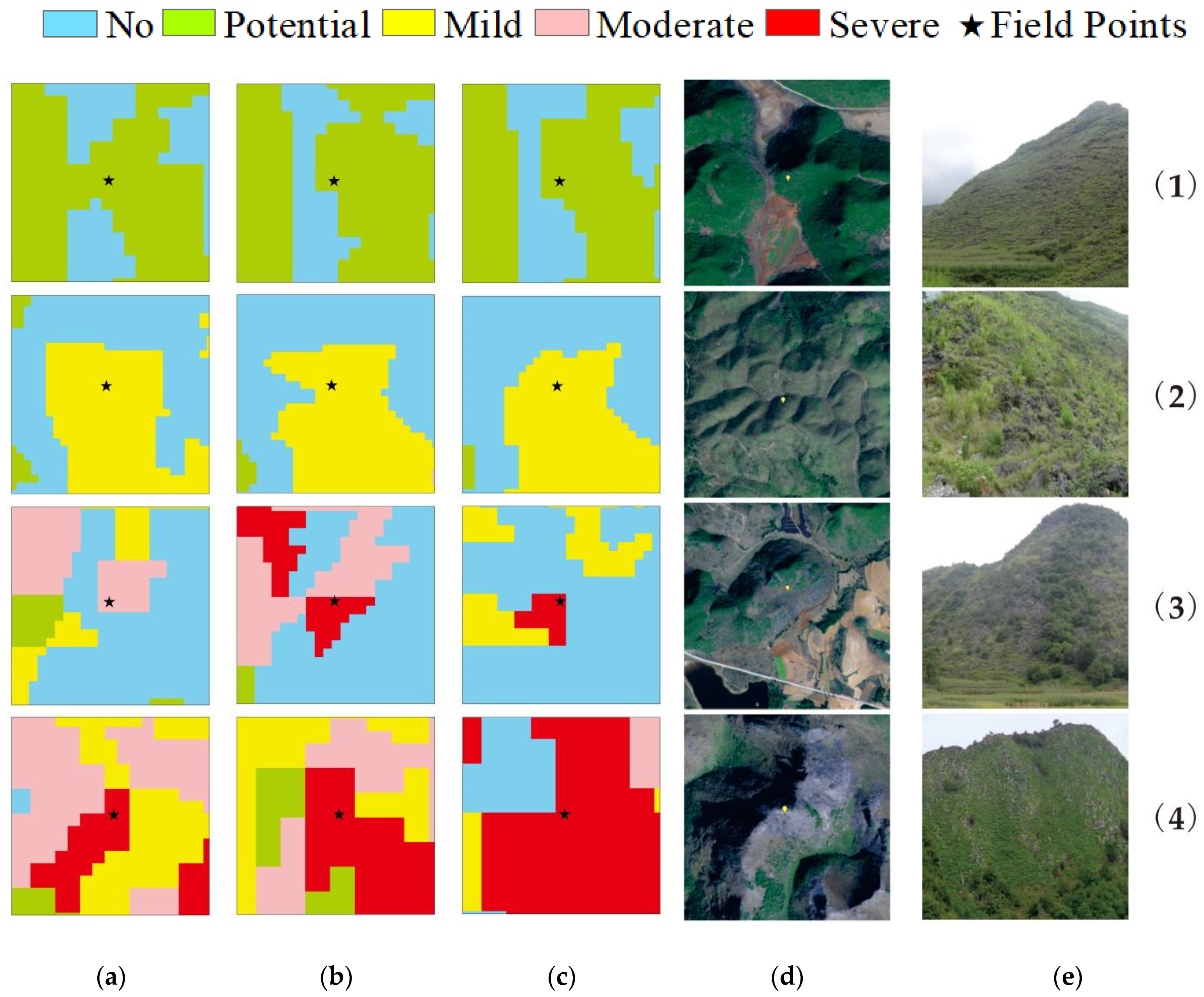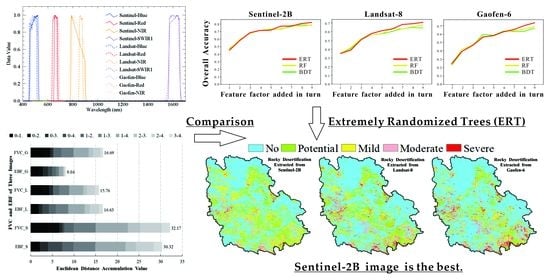Extracting Information on Rocky Desertification from Satellite Images: A Comparative Study
Abstract
:1. Introduction
2. Study Area and Data
2.1. Study Area
2.2. Satellite Image Data and Other Data
3. Methods
3.1. Calculation of Factors
3.1.1. Calculation of Remotely Sensed Factors
3.1.2. Calculation of Other Factors
3.2. Method for Comparing Separability
3.3. Model Construction for Information Extraction
3.4. Accuracy Assessment
4. Results
4.1. Information Analysis of Three Types of Images
4.1.1. Contrast of Spectral Reflection Information
4.1.2. Separability of FVC and EBF for Rocky Desertification
4.2. Extraction Results of Rocky Desertification
4.2.1. Comparison of the Classification Accuracy of Three Methods
4.2.2. Comparison of Classification Results Based on Factors Selection
4.2.3. Accuracy Evaluation of Extraction Results
4.2.4. Comparison of Extraction Results of Rocky Desertification
5. Discussion
5.1. Accuracy of Information Extraction from Three Types of Images
5.2. Applicability of ERT for Extracting Information of Rocky Desertification
5.3. Study Limitations
6. Conclusions
Author Contributions
Funding
Institutional Review Board Statement
Informed Consent Statement
Data Availability Statement
Conflicts of Interest
References
- Beynen, P.E. Karst Management; Springer: Dordrecht, The Netherlands, 2011. [Google Scholar]
- Zhang, M.; Wang, K.; Liu, H.; Zhang, C.; Yue, Y.; Qi, X. Effect of ecological engineering projects on ecosystem services in a karst region: A case study of northwest Guangxi, China. J. Clean. Prod. 2018, 183, 831–842. [Google Scholar] [CrossRef]
- Cheng, F.; Lu, H.; Ren, H.; Zhou, L.; Zhang, L.; Li, J.; Lu, X.; Huang, D.; Zhao, D. Integrated emergy and economic evaluation of three typical rocky desertification control modes in karst areas of Guizhou Province, China. J. Clean. Prod. 2017, 161, 1104–1128. [Google Scholar] [CrossRef]
- Pei, J.; Wang, L.; Huang, N.; Geng, J.; Cao, J.; Niu, Z. Analysis of Landsat-8 OLI Imagery for Estimating Exposed Bedrock Fractions in Typical Karst Regions of Southwest China Using a Karst Bare-Rock Index. Remote Sens. 2018, 10, 1321. [Google Scholar] [CrossRef] [Green Version]
- Peng, X.; Dai, Q.; Ding, G.; Shi, D.; Li, C. Impact of vegetation restoration on soil properties in near-surface fissures located in karst rocky desertification regions. Soil Tillage Res. 2020, 200, 104620. [Google Scholar] [CrossRef]
- Hu, Y.; Han, Y.; Zhang, Y. Information Extraction and Spatial Distribution of Research Hot Regions on Rocky Desertification in China. Appl. Sci. 2018, 8, 2075. [Google Scholar] [CrossRef] [Green Version]
- Sandhu, D.; Singh, A.; Wang, D. Can we infer the age of karst conduit from the profile of potentiometric surface? J. Hydrol. 2020, 584, 124679. [Google Scholar] [CrossRef]
- Yan, Y.; Dai, Q.; Hu, G.; Jiao, Q.; Mei, L.; Fu, W. Effects of vegetation type on the microbial characteristics of the fissure soil-plant systems in karst rocky desertification regions of SW China. Sci. Total Environ. 2020, 712, 136543. [Google Scholar] [CrossRef]
- Tang, J.; Tang, X.; Qin, Y.; He, Q.; Yi, Y.; Ji, Z. Karst rocky desertification progress: Soil calcium as a possible driving force. Sci. Total Environ. 2019, 649, 1250–1259. [Google Scholar] [CrossRef] [PubMed]
- Jiang, Z.; Lian, Y.; Qin, X. Rocky desertification in Southwest China: Impacts, causes, and restoration. Earth Sci. Rev. 2014, 132, 1–12. [Google Scholar] [CrossRef]
- Tong, X.; Wang, K.; Yue, Y.; Brandt, M.; Liu, B.; Zhang, C.; Liao, C.; Fensholt, R. Quantifying the effectiveness of ecological restoration projects on long-term vegetation dynamics in the karst regions of Southwest China. Int. J. Appl. Earth Obs. 2017, 54, 105–113. [Google Scholar] [CrossRef] [Green Version]
- Sathyendranath, S.; Platt, T.; Horne, E.P.W.; Harrison, W.G.; Ulloa, O.; Outerbridge, R.; Hoepffner, N. Estimation of new production in the ocean by compound remote sensing. Nature 1991, 353, 129–133. [Google Scholar] [CrossRef]
- Paul, C.K.; Mascarenhas, A.C. Remote Sensing in Development. Science 1981, 214, 139–145. [Google Scholar] [CrossRef]
- Li, J.; Pei, Y.; Zhao, S.; Xiao, R.; Sang, X.; Zhang, C. A Review of Remote Sensing for Environmental Monitoring in China. Remote Sens. 2020, 12, 1130. [Google Scholar] [CrossRef] [Green Version]
- Ajaj, Q.M.; Pradhan, B.; Noori, A.M.; Jebur, M.N. Spatial Monitoring of Desertification Extent in Western Iraq using Landsat Images and GIS. Land Degrad. Dev. 2017, 28, 2418–2431. [Google Scholar] [CrossRef]
- Wulder, M.A.; White, J.C.; Loveland, T.R.; Woodcock, C.E.; Belward, A.S.; Cohen, W.B.; Fosnight, E.A.; Shaw, J.; Masek, J.G.; Roy, D.P. The global Landsat archive: Status, consolidation, and direction. Remote Sens. Environ. 2016, 185, 271–283. [Google Scholar] [CrossRef] [Green Version]
- Li, S.; Wu, H. Mapping karst rocky desertification using Landsat 8 images. Remote Sens. Lett. 2015, 6, 657–666. [Google Scholar] [CrossRef]
- Wang, H.; Li, Q.; Du, X.; Zhao, L. Quantitative extraction of the bedrock exposure rate based on unmanned aerial vehicle data and Landsat-8 OLI image in a karst environment. Front. Earth Sci. 2017, 12, 481–490. [Google Scholar] [CrossRef]
- Chen, L.; Lin, H.; Sun, H. Studies on space and time evolution of karst rocky desertifi cation area in Lengshuijiang city based on SPOT-5 images. J. Cen. South Uni. Tech. 2012, 32, 22–27. (In Chinese) [Google Scholar] [CrossRef]
- Qi, X.; Zhang, C.; Wang, K. Comparing Remote Sensing Methods for Monitoring Karst Rocky Desertification at Sub-pixel Scales in a Highly Heterogeneous Karst Region. Sci. Rep. 2019, 9, 1–12. [Google Scholar] [CrossRef] [PubMed] [Green Version]
- Yue, Y.; Wang, K.; Liu, B.; Li, R.; Zhang, B.; Chen, H.; Zhang, M. Development of new remote sensing methods for mapping green vegetation and exposed bedrock fractions within heterogeneous landscapes. Int. J. Remote Sens. 2013, 34, 5136–5153. [Google Scholar] [CrossRef]
- Birk, R.J.; Stanley, T.; Snyder, G.I.; Hennig, T.A.; Fladeland, M.M.; Policelli, F. Government programs for research and operational uses of commercial remote sensing data. Remote Sens. Environ. 2003, 88, 3–16. [Google Scholar] [CrossRef]
- Zhu, D.Y.; Xiong, K.N.; Xiao, H.; Lan, J.C. Comparison of Rocky Desertification Detection Ability of GF-1 and Landsat-OLI Based on Vegetation Index. J. Nat. Res. 2016, 31, 1949–1957. (In Chinese) [Google Scholar] [CrossRef]
- Drusch, M.; Del Bello, U.; Carlier, S.; Colin, O.; Fernandez, V.; Gascon, F.; Hoersch, B.; Isola, C.; Laberinti, P.; Martimort, P.; et al. Sentinel-2: ESA’s Optical High-Resolution Mission for GMES Operational Services. Remote Sens. Environ. 2012, 120, 25–36. [Google Scholar] [CrossRef]
- Meyer, L.H.; Heurich, M.; Beudert, B.; Premier, J.; Pflugmacher, D. Comparison of Landsat-8 and Sentinel-2 Data for Estimation of Leaf Area Index in Temperate Forests. Remote Sens. 2019, 11, 1160. [Google Scholar] [CrossRef] [Green Version]
- Akbari, E.; Boloorani, A.D.; Samany, N.N.; Hamzeh, S.; Soufizadeh, S.; Pignatti, S. Crop Mapping Using Random Forest and Particle Swarm Optimization based on Multi-Temporal Sentinel-2. Remote Sens. 2020, 12, 1449. [Google Scholar] [CrossRef]
- Kpienbaareh, D.; Kansanga, M.; Luginaah, I. Examining the potential of open source remote sensing for building effective decision support systems for precision agriculture in resource-poor settings. GeoJournal 2018, 84, 1481–1497. [Google Scholar] [CrossRef]
- Turner, W.; Rondinini, C.; Pettorelli, N.; Mora, B.; Leidner, A.; Szantoi, Z.; Buchanan, G.; Dech, S.; Dwyer, J.; Herold, M.; et al. Free and open-access satellite data are key to biodiversity conservation. Biol. Conserv. 2015, 182, 173–176. [Google Scholar] [CrossRef] [Green Version]
- Yao, M.; Zhou, G.; Wang, W.; Wu, Z.; Huang, Y.; Huang, X. Study on karst information identification of qiandongnan prefecture based on RS and GIS technology. Remote Sens. Spat. Inf. Sci. 2018, XLII-3, 2121–2125. [Google Scholar] [CrossRef] [Green Version]
- Xia, G.-S.; Wang, Z.; Xiong, C.; Zhang, L. Accurate Annotation of Remote Sensing Images via Active Spectral Clustering with Little Expert Knowledge. Remote Sens. 2015, 7, 15014–15045. [Google Scholar] [CrossRef] [Green Version]
- Su, C.J.; Yue, T.; Jiang, L.; Li, X.M.; Wang, W.G. Karst rocky desertification information extraction based on the decision tree. Remote Sens. Spat. Inf. Sci. 2020, XLII-3/W10, 367–373. [Google Scholar] [CrossRef] [Green Version]
- Liu, K.; Shi, W.; Zhang, H. A fuzzy topology-based maximum likelihood classification. ISPRS J. Photogramm. Remote Sens. 2011, 66, 103–114. [Google Scholar] [CrossRef]
- Zhou, G.; Wang, L. Co-location decision tree for enhancing decision-making of pavement maintenance and rehabilitation. Transp. Res. Part C Emerg. Technol. 2012, 21, 287–305. [Google Scholar] [CrossRef] [Green Version]
- Huang, P.; Peng, L.; Pan, H. Linking the Random Forests Model and GIS to Assess Geo-Hazards Risk: A Case Study in Shifang County, China. IEEE Access 2020, 8, 28033–28042. [Google Scholar] [CrossRef]
- Ellenson, A.; Pei, Y.; Wilson, G.; Özkan-Haller, H.T.; Fern, X. An application of a machine learning algorithm to determine and describe error patterns within wave model output. Coast. Eng. 2020, 157, 103595. [Google Scholar] [CrossRef]
- Julian, D. Designing Machine Learning Systems with Python; Packt: Birmingham, UK, 2016. [Google Scholar]
- Xu, Y.; Zhao, X.; Chen, Y.; Yang, Z. Research on a Mixed Gas Classification Algorithm Based on Extreme Random Tree. Appl. Sci. 2019, 9, 1728. [Google Scholar] [CrossRef] [Green Version]
- Geurts, P.; Ernst, D.; Wehenkel, L. Extremely randomized trees. Mach. Learn. 2006, 63, 3–42. [Google Scholar] [CrossRef] [Green Version]
- Shang, K.; Yao, Y.; Li, Y.; Yang, J.; Jia, K.; Zhang, X.; Chen, X.; Bei, X.; Guo, X. Fusion of Five Satellite-Derived Products Using Extremely Randomized Trees to Estimate Terrestrial Latent Heat Flux over Europe. Remote Sens. 2020, 12, 687. [Google Scholar] [CrossRef] [Green Version]
- Rahmati, O.; Mohammadi, F.; Ghiasi, S.S.; Tiefenbacher, J.; Moghaddam, D.D.; Coulon, F.; Nalivan, O.A.; Bui, D.T. Identifying sources of dust aerosol using a new framework based on remote sensing and modelling. Sci. Total Environ. 2020, 737, 139508. [Google Scholar] [CrossRef] [PubMed]
- Ebrahimy, H.; Feizizadeh, B.; Salmani, S.; Azadi, H. A comparative study of land subsidence susceptibility mapping of Tasuj plane, Iran, using boosted regression tree, random forest and classification and regression tree methods. Environ. Earth Sci. 2020, 79, 1–12. [Google Scholar] [CrossRef]
- Paul, A.; Furmanchuk, A.; Liao, W.; Choudhary, A.; Agrawal, A. Property Prediction of Organic Donor Molecules for Photovoltaic Applications Using Extremely Randomized Trees. Mol. Inf. 2019, 38, e1900038. [Google Scholar] [CrossRef] [PubMed]
- Wei, J.; Li, Z.; Cribb, M.; Huang, W.; Xue, W.; Sun, L.; Guo, J.; Peng, Y.; Li, J.; Lyapustin, A.; et al. Improved 1 km resolution PM2.5 estimates across China using enhanced space–time extremely randomized trees. Atm. Chem. Phys. Discuss. 2020, 20, 3273–3289. [Google Scholar] [CrossRef] [Green Version]
- Wang, S.-J.; Liu, Q.-M.; Zhang, D.-F. Karst rocky desertification in southwestern China: Geomorphology, landuse, impact and rehabilitation. Land Degrad. Dev. 2004, 15, 115–121. [Google Scholar] [CrossRef]
- Sweeting, M.M. Karst in China: Its Geomorphology and Environment; Springer: Berlin/Heidelberg, Germany, 1995. [Google Scholar]
- Yue, Y.; Wang, K.; Zhang, B.; Jiao, Q.; Liu, B.; Zhang, M. Remote sensing of fractional cover of vegetation and exposed bedrock for karst rocky desertification assessment. Procedia Environ. Sci. 2012, 13, 847–853. [Google Scholar] [CrossRef] [Green Version]
- Pu, J.-W.; Zhao, X.-Q.; Miao, P.-P.; Li, S.-N.; Tan, K.; Wang, Q.; Tang, W. Integrating multisource RS data and GIS techniques to assist the evaluation of resource-environment carrying capacity in karst mountainous area. J. Mt. Sci. 2020, 17, 2528–2547. [Google Scholar] [CrossRef]
- Gan, S.; Yuan, X.P.; Sun, G.; Zhang, X.L.; Li, Y. Karst Rocky Desertification Remote Sensing Monitoring by Integrating Land Use Diagnoses in Southeast of Yunnan Province. Appl. Mech. Mater. 2013, 444–445, 869–873. [Google Scholar] [CrossRef]
- Zhang, Z.; Xu, W.; Zhou, W.; Zhang, L.; Xiao, Y.; Ou, X.; Ouyang, Z. Integrating remote sensing with GIS-based multi-criteria evaluation approach for Karst rocky desertification assessment in Southwest of China. IOP Conf. Ser. Earth Environ. Sci. 2014, 18, 012038. [Google Scholar] [CrossRef] [Green Version]
- Xie, X.; Du, P.; Xia, J.; Luo, J. Spectral Indices for Estimating Exposed Carbonate Rock Fraction in Karst Areas of Southwest China. IEEE Geosci. Remote Sens. Lett. 2015, 12, 1988–1992. [Google Scholar] [CrossRef]
- Zhong, S.; Li, Y.; Wu, C.; Lu, W.; Yang, X. TM and ETM Image Based Monitoring on Rocky Desertification in Region of the Return Farmland Pasture or Forest in Tiandong County Guangxi Province, China. Sens. Lett. 2012, 10, 301–308. [Google Scholar] [CrossRef]
- Abdi, A.M. Land cover and land use classification performance of machine learning algorithms in a boreal landscape using Sentinel-2 data. GIScience Remote Sens. 2020, 57, 1–20. [Google Scholar] [CrossRef] [Green Version]
- Wang, D.; Wan, B.; Qiu, P.; Su, Y.; Guo, Q.; Wang, R.; Sun, F.; Wu, X. Evaluating the Performance of Sentinel-2, Landsat 8 and Pléiades-1 in Mapping Mangrove Extent and Species. Remote Sens. 2018, 10, 1468. [Google Scholar] [CrossRef] [Green Version]
- Mancino, G.; Ferrara, A.; Padula, A.; Nolè, A. Cross-Comparison between Landsat 8 (OLI) and Landsat 7 (ETM+) Derived Vegetation Indices in a Mediterranean Environment. Remote Sens. 2020, 12, 291. [Google Scholar] [CrossRef] [Green Version]
- Yang, A.; Zhong, B.; Hu, L.; Wu, S.; Xu, Z.; Wu, H.; Wu, J.; Gong, X.; Wang, H.; Liu, Q. Radiometric Cross-Calibration of the Wide Field View Camera Onboard GaoFen-6 in Multispectral Bands. Remote Sens. 2020, 12, 1037. [Google Scholar] [CrossRef] [Green Version]
- Mondal, P.; McDermid, S.S.; Qadir, A. A reporting framework for Sustainable Development Goal 15: Multi-scale monitoring of forest degradation using MODIS, Landsat and Sentinel data. Remote Sens. Environ. 2020, 237, 111592. [Google Scholar] [CrossRef]
- Zhang, M.; Wang, K.; Liu, H.; Zhang, C.; Wang, J.; Yue, Y.; Qi, X. How ecological restoration alters ecosystem services: An analysis of vegetation carbon sequestration in the karst area of northwest Guangxi, China. Environ. Earth Sci. 2015, 74, 5307–5317. [Google Scholar] [CrossRef]
- Imanian, A.; Tangestani, M.H.; Asadi, A. Investigation of spectral characteristics of carbonate rocks—a case study on Posht Moleh Mountain in Iran. Remote Sens. Spat. Inf. Sci. 2019, XLII-4/W18, 553–557. [Google Scholar] [CrossRef] [Green Version]
- Gorelick, N.; Hancher, M.; Dixon, M.; Ilyushchenko, S.; Thau, D.; Moore, R. Google Earth Engine: Planetary-scale geospatial analysis for everyone. Remote Sens. Environ. 2017, 202, 18–27. [Google Scholar] [CrossRef]
- Gupta, S.; Arango-Argoty, G.; Zhang, L.; Pruden, A.; Vikesland, P. Identification of discriminatory antibiotic resistance genes among environmental resistomes using extremely randomized tree algorithm. Microbiome 2019, 7, 1–15. [Google Scholar] [CrossRef] [PubMed]
- Hou, W.; Gao, J.; Wu, S.; Dai, E. Interannual Variations in Growing-Season NDVI and Its Correlation with Climate Variables in the Southwestern Karst Region of China. Remote Sens. 2015, 7, 11105–11124. [Google Scholar] [CrossRef] [Green Version]
- Xu, E.; Zhang, H.; Li, M. Object-Based Mapping of Karst Rocky Desertification using a Support Vector Machine. Land Degrad. Dev. 2012, 26, 158–167. [Google Scholar] [CrossRef]
- Lu, D.; Weng, Q. A survey of image classification methods and techniques for improving classification performance. Int. J. Remote Sens. 2007, 28, 823–870. [Google Scholar] [CrossRef]








| No. | Name | Type | Sources | Descriptions |
|---|---|---|---|---|
| 1 | Sentinel-2B Satellite Image Data | Raster data | https://scihub.copernicus.eu/, accessed on 20 March 2019 | After pre-processing, these images were used for information extraction of rocky desertification. All images were taken during the dry season and have a cloud cover of less than 1% in study area. |
| 2 | Landsat-8 Satellite Image Data | https://earthexplorer.usgs.gov/, accessed on 22 March 2019 | ||
| 3 | Gaofen-6 Satellite Image Data | http://www.cnsageo.com/#/, accessed on 7 February 2019 | ||
| 4 | NASA DEM | https://earthdata.nasa.gov/esds/competitive-programs/measures/nasadem, accessed on 27 March 2019 | The digital elevation model (DEM) data have a spatial resolution of 12.5m and were used for extracting topographic factors, such as elevation, slope, and aspect of the study area. | |
| 5 | Rock types | Vector data | http://www.resdc.cn/, accessed on 3 February 2019 | Rock types of Guangnan County were used as one of the factors in information extraction of rocky desertification. |
| 6 | Land use database in 2019 of Guangnan County | Bureau of Nature Resources of Guangnan County | Land use data in the study area and the administrative boundary. | |
| 7 | Soil data of Guangnan County | Bureau of Agricultural Technology of Guangnan County | The data were used to extract types and thickness of soil as factors assessing the status of rocky desertification. |
| Data Type | Optical Instrument | Bands | Radiometric Resolution | Spatial Resolution | Temporal Resolution | Time Range |
|---|---|---|---|---|---|---|
| Sentinel-2 | Multispectral Instrument (MSI) | Band 1 (Coastal Aerosol) Band 2 (Blue) Band 3 (Green) Band 4 (Red) Band 5 (Red Edge 1) Band 6 (Red Edge 2) Band 7 (Red Edge 3) Band 8 (NIR) Band 8a (Narrow NIR) Band 9 (Water Vapour) Band 10 (SWIR) Band 11 (SWIR 1) Band 12 (SWIR 2) | 430–457 nm 440–538 nm 537–582 nm 646–684 nm 694–713 nm 713–749 nm 769–797 nm 760–908 nm 848–881 nm 932–958 nm 1337–1412 nm 1539–1682 nm 2017–2320 nm | 60 m 10 m 10 m 10 m 20 m 20 m 20 m 10 m 20 m 60 m 60 m 20 m 20 m | 10 days with one satellite, 5 days with two satellites | From January 2015 (Sentinel-2A) From March 2017 (Sentinel-2B) |
| Landsat-8 | Operational Land Imager (OLI) | Band 1 (Coastal) Band 2 (Blue) Band 3 (Green) Band 4 (Red) Band 5 (NIR) Band 6 (SWIR 1) Band 7 (SWIR 2) Band 9 (Cirrus) | 433–453 nm 450–515 nm 525–600 nm 630–680 nm 845–885 nm 1560–1660 nm 2100–2300 nm 1360–1390 nm | 30 m | 16 days | From February 2013 |
| Gaofen-6 | Wide Field of View Multispectral Imager (WFV) | Band 1 (Blue) Band 2 (Green) Band 3 (Red) Band 4 (NIR) Band 5 (Red Edge 1) Band 6 (Red Edge 2) Band 7 (Coast Blue) Band 8 (Yellow) | 450–528 nm 520–600 nm 633–691 nm 774–892 nm 685–723 nm 731–773 nm 405–456 nm 591–631 nm | 16 m | 4 days | From June 2018 |
| Rocky Desertification Levels | Training Samples | Validation Samples | Total Samples | Descriptions [20,31,51] |
|---|---|---|---|---|
| No Rocky Desertification | 447 | 191 | 638 | There is no rocky desertification. |
| Potential Level | 169 | 72 | 241 | The proportion of exposed rock is less than 30%. |
| Mild Level | 319 | 136 | 455 | The proportion of exposed rock is between 30% and 50%. |
| Moderate Level | 377 | 161 | 538 | The proportion of exposed rock is between 50% and 70%. |
| Severe Level | 395 | 169 | 564 | The proportion of exposed rock is more than 70%. |
| Total | 1707 | 729 | 2436 | / |
| Satellites | Blue Band | Red Band | NIR Band | SWIR1 Band |
|---|---|---|---|---|
| Sentinel-2B | √ Band range: 440–538 nm | √ Band range: 646–684 nm | √ Band range: 760–908 nm | √ Band range: 1539–1682 nm |
| Landsat-8 | √ Band range: 450–515 nm | √ Band range: 630–680 nm | √ Band range: 845–885 nm | √ Band range: 1560–1660 nm |
| Gaofen-6 | √ Band range: 450–528 nm | √ Band range: 633–691 nm | √ Band range: 774–892 nm | × |
| Similarities and differences | The band range is not very different. | The band range is not very different. | The band range of Landsat-8 is relatively narrow, ignoring the “red-edge” band of 760 –690 nm, which is an important range for vegetation detection. The other two satellites have “red-edge” bands, with similar wavelength ranges. | There is not much difference between Sentinel-2B and Landsat-8, while the Gaofen-6 is missing this band. |
Publisher’s Note: MDPI stays neutral with regard to jurisdictional claims in published maps and institutional affiliations. |
© 2021 by the authors. Licensee MDPI, Basel, Switzerland. This article is an open access article distributed under the terms and conditions of the Creative Commons Attribution (CC BY) license (https://creativecommons.org/licenses/by/4.0/).
Share and Cite
Pu, J.; Zhao, X.; Dong, P.; Wang, Q.; Yue, Q. Extracting Information on Rocky Desertification from Satellite Images: A Comparative Study. Remote Sens. 2021, 13, 2497. https://0-doi-org.brum.beds.ac.uk/10.3390/rs13132497
Pu J, Zhao X, Dong P, Wang Q, Yue Q. Extracting Information on Rocky Desertification from Satellite Images: A Comparative Study. Remote Sensing. 2021; 13(13):2497. https://0-doi-org.brum.beds.ac.uk/10.3390/rs13132497
Chicago/Turabian StylePu, Junwei, Xiaoqing Zhao, Pinliang Dong, Qian Wang, and Qifa Yue. 2021. "Extracting Information on Rocky Desertification from Satellite Images: A Comparative Study" Remote Sensing 13, no. 13: 2497. https://0-doi-org.brum.beds.ac.uk/10.3390/rs13132497








